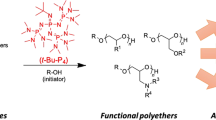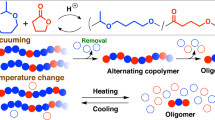Abstract
With increased environmental concerns and the rising demands for sustainable polymers, e.g., degradable polymers and chemically recyclable polymers, studies on ring-opening polymerization (ROP) of cyclic esters have been developed in recent decades. Biorenewable five-membered γ-butyrolactone (γBL) may be a desirable feedstock for the chemical synthesis of poly(γ-butyrolactone) (PγBL) or for the incorporation of γBL units into polyester chains to modify their properties. Although γBL is traditionally considered to be “nonpolymerizable”, some progress was recently made concerning the ROP of γBL. This mini-review is thus specifically focused on the ROP of γBL and its copolymerization with other cyclic esters.
This is a preview of subscription content, access via your institution
Access options
Subscribe to this journal
Receive 12 print issues and online access
$259.00 per year
only $21.58 per issue
Buy this article
- Purchase on Springer Link
- Instant access to full article PDF
Prices may be subject to local taxes which are calculated during checkout














Similar content being viewed by others
References
Longo JM, Sanford MJ, Coates GW. Ring-opening copolymerization of epoxides and cyclic anhydrides with discrete metal complexes: structure–property relationships. Chem Rev. 2016;116:15167–97.
Hillmyer MA, Tolman WB. Aliphatic polyester block polymers: renewable, degradable, and sustainable. Acc Chem Res. 2014;47:2390–6.
Schneiderman DK, Hillmyer MA. Aliphatic polyester block polymer design. Macromolecules. 2016;49:2419–28.
Gonçalves FAMM, Fonseca AC, Domingos M, Gloria A, Serra AC, JFJ Coelho. The potential of unsaturated polyesters in biomedicine and tissue engineering: synthesis, structure-properties relationships and additive manufacturing. Prog Polym Sci. 2017;68:1–34.
Kamber NE, Jeong W, Waymouth RM, Pratt RC, Lohmeijer BG, Hedrick JL. Organocatalytic ring-opening polymerization. Chem Rev. 2007;107:5813–40.
Penczek S, Cypryk M, Duda A, Kubisa P, Slomkowski S. Living ring-opening polymerizations of heterocyclic monomers. Prog Polym Sci. 2007;32:247–82.
Jerome C, Lecomte P. Recent advances in the synthesis of aliphatic polyesters by ring-opening polymerization. Adv Drug Deliv Rev. 2008;60:1056–76.
Hu S, Zhao J, Zhang G, Schlaad H. Macromolecular architectures through organocatalysis. Prog Polym Sci. 2017;74:34–77.
Moore T, Adhikari R, Gunatillake P. Chemosynthesis of bioresorbable poly(gamma-butyrolactone) by ring-opening polymerisation: a review. Biomaterials. 2005;26:3771–82.
Nakayama A, Kawasaki N, Aiba S, Maeda Y, Arvanitoyannis I, Yamamoto N. Synthesis and biodegradability of novel copolyesters containg γ-butyrolactone units. Polymer. 1998;39:1213–22.
Houk K, Jabbari A, Hall H, Alemán C. Why δ-valerolactone polymerizes and γ-butyrolactone does not. J Org Chem. 2008;73:2674–8.
Dubois P, Coulembier O, Raquez J-M. Handbook of Ring-Opening Polymerization. 2009. Ch. 1, p. 1–51
Aleman C, Betran O, Casanovas J, Houk KN, Hall HK Jr. Thermodynamic control of the polymerizability of five-, six-, and seven-membered lactones. J Org Chem. 2009;74:6237–44.
Saiyasombat W, Molloy R, Nicholson TM, Johnson AF, Ward IM, Poshyachinda S. Ring strain and polymerizability of cyclic esters. Polymer. 1998;39:5581–5.
Carothers WH, Dorough GL, Natta FJv. Studies of polymerization and ring formation. X. The reversible polymerization of six-membered cyclic esters. J Am Chem Soc. 1932;54:761–72.
Hall HK, Schneider AK. Polymerization of cyclic esters, urethans, ureas and imides. J Am Chem Soc. 1958;80:6409–12.
Korte F, Glet W. Hochdruckreaktionen. II. Die polymerisation von γ-Butyrolacton und δ-Valerolactam bei hohen drücken. J Polym Sci Part B: Polym Lett. 1966;4:685–9.
Hong M, Chen EY. Completely recyclable biopolymers with linear and cyclic topologies via ring-opening polymerization of gamma-butyrolactone. Nat Chem. 2016;8:42–9.
Hong M, Chen EY. Towards truly sustainable polymers: a metal-free recyclable polyester from biorenewable non-strained gamma-butyrolactone. Angew Chem Int Ed Engl. 2016;55:4188–93.
Zhao N, Ren C, Li H, Li Y, Liu S, Li Z. Selective ring-opening polymerization of non-strained gamma-butyrolactone catalyzed by a cyclic trimeric phosphazene base. Angew Chem Int Ed Engl. 2017;56:12987–90.
Walther P, Frey W, Naumann S. Polarized olefins as enabling (co)catalysts for the polymerization of γ-butyrolactone. Polym Chem. 2018;9:3674–83.
Zhang C-J, Hu L-F, Wu H-L, Cao X-H, Zhang X-H. Dual organocatalysts for highly active and selective synthesis of linear poly(γ-butyrolactone)s with high molecular weights. Macromolecules. 2018;51:8705–11.
Lin L, Han D, Qin J, Wang S, Xiao M, Sun L, et al. Nonstrained γ-butyrolactone to high-molecular-weight poly(γ-butyrolactone): facile bulk polymerization using economical ureas/alkoxides. Macromolecules. 2018;51:9317–22.
Olsen P, Odelius K, Albertsson AC. Thermodynamic presynthetic considerations for ring-opening polymerization. Biomacromolecules. 2016;17:699–709.
Shen Y, Zhao Z, Li Y, Liu S, Liu F, Li Z. A facile method to prepare high molecular weight bio-renewable poly(γ-butyrolactone) using a strong base/urea binary synergistic catalytic system. Polym Chem. 2019;10:1231–7.
Shen Y, Zhang J, Zhao Z, Zhao N, Liu F, Li Z. Preparation of amphiphilic poly(ethylene glycol)- b-poly(gamma-butyrolactone) diblock copolymer via ring opening polymerization catalyzed by a cyclic trimeric phosphazene base or alkali alkoxide. Biomacromolecules. 2019;20:141–8.
Bhaw-Luximon A, Jhurry D, Motala-Timol S, Lochee Y. Polymerization of ɛ-caprolactone and its copolymerization with γ-butyrolactone using metal complexes. Macromol Symposia. 2005;231:60–8.
Hong M, Tang X, Newell BS, Chen EYX. “Nonstrained” γ-butyrolactone-based copolyesters: copolymerization characteristics and composition-dependent (thermal, eutectic, cocrystallization, and degradation) properties. Macromolecules. 2017;50:8469–79.
Tada K, Numata Y, Saegusa T, Furukawa J. Copolymerization of γ-butyrolactone and β-propiolactone. Makromol Chem. 1964;77:220–8.
Kricheldorf HR, Mang T, Jonté JM. Polylactones, 2 copolymerization of glycolide with β-propiolactone, γ-butyrolactone or δ-valerolactone. Makromol Chem. 1985;186:955–76.
Duda A, Penczek S, Dubois P, Mecerreyes D, Jérôme R. Oligomerization and copolymerization of γ-butyrolactone—a monomer known as unable to homopolymerize, 1. Copolymerization with ɛ-caprolactone. Macromol Chem Phys. 1996;197:1273–83.
Duda A, Biela T, Libiszowski J, Penczek S, Dubois P, Mecerreyes D, et al. Block and random copolymers of ε-caprolactone. Polym Degrad Stab. 1998;59:215–22.
Duda A, Libiszowski J, Mosnáček J, Penczek S. Copolymerization of cyclic esters at the living polymer-monomer equilibrium. Macromol Symposia. 2005;226:109–20.
Nakayama A, Kawasaki N, Arvanitoyannis I, Aiba S, Yamamoto N. Synthesis and biodegradation of poly(γ-butyrolactone-co-l-lactide). J Environ Polym Degrad. 1996;4:205–11.
Wei Z, Liu L, Qi M. Synthesis and characterization of homo- and co-polymers of (R,S)-β-butyrolactone and γ-butyrolactone or β-valerolactone initiated with cyclic tin alkoxide. React Funct Polym. 2006;66:1411–9.
Hori Y, Yamaguchi A, Hagiwara T. Chemical synthesis of high molecular weight poly(3-hydroxybutyrate-co-4-hydroxybutyrate). Polymer. 1995;36:4703–5.
Nishiura M, Hou Z, Koizumi T-a, Imamoto T, Wakatsuki Y. Ring-opening polymerization and copolymerization of lactones by samarium(II) aryloxide complexes. Macromolecules. 1999;32:8245–51.
Agarwal S, Xie X. SmI2/Sm-Based γ-Buyrolactone−ε-Caprolactone Copolymers: Microstructural Characterization Using One- and Two-Dimensional NMR Spectroscopy. Macromolecules. 2003;36:3545–9.
Nederberg F, Connor EF, Möller M, Glauser T, Hedrick JL. New paradigms for organic catalysts: the first organocatalytic living polymerization. Angew Chem Int Ed Engl. 2001;40:2712–5.
Carlotti S, Peruch F. Cyclic monomers: epoxides, lactide, lactones, lactams, cyclic silicon-containing monomers, cyclic carbonates and others. In: Hadjichristidis N, Hirao, A, editors. Anionic polymerization: principles, practice, strength, consequences, and applications. Japan: Springer; 2015. p. 191−305.
Shen Y, Zhang J, Zhao N, Liu F, Li Z. Preparation of biorenewable poly(γ-butyrolactone)-b-poly(l-lactide) diblock copolyesters via one-pot sequential metal-free ring-opening polymerization. Polym Chem. 2018;9:2936–41.
Walther P, Naumann S. N-Heterocyclic olefin-based (co)polymerization of a challenging monomer: homopolymerization of ω-pentadecalactone and its copolymers with γ-butyrolactone, δ-valerolactone, and ε-caprolactone. Macromolecules. 2017;50:8406–16.
Meerwein H. Uber oxoniumverbindungen des Säure-ester und lactone. Angew Chem. 1951;63:480–1.
Ito K, Inoue T, Yamashita Y. Copolymerizations of 3.3-bis(chloromethyl)oxacyclobutane with β-propiolactone and γ-butyrolactone by lewis acids: “Two-state“ polymerization mechanism. Makromol Chem. 1970;139:153–64.
Lee CW, Urakawa R, Kimura Y. Copolymerization of γ-butyrolactone and β-butyrolactone. Macromol Chem Phys. 1997;198:1109–20.
Yamashita K, Yamamoto K, Kadokawa J-i. Acid-catalyzed ring-opening polymerization of γ-butyrolactone under high-pressure conditions. Chem Lett. 2014;43:213–5.
Lin WJ. Comparison of thermal characteristics and degradation properties of epsilon-caprolactone copolymers. J Biomed Mater Res. 1999;47:420–3.
Nobes GAR, Kazlauskas RJ, Marchessault RH. Lipase-catalyzed ring-opening polymerization of lactones: a novel route to poly(hydroxyalkanoate)s. Macromolecules. 1996;29:4829–33.
Dong H, Wang H-d, Cao S-g, Shen J-c. Lipase-catalyzed polymerization of lactones and linear hydroxyesters. Biotechnol Lett. 1998;20:905–8.
Gorke JT, Okrasa K, Louwagie A, Kazlauskas RJ, Srienc F. Enzymatic synthesis of poly(hydroxyalkanoates) in ionic liquids. J Biotechnol. 2007;132:306–13.
Kadokawa J, Iwasaki Y, Tagaya H. Ring-opening polymerization of lactones catalyzed by ion-exchanged clay montmorillonite. Green Chem. 2002;4:14–6.
Miura H, Tajima T, Nagata M, Royama T, Saito K, Hasegawa M. Synthesis of poly(ester ether)s by the reaction of .GAMMA.-butyrolactone with diols and their application to polyurthaues. Kobunshi Ronbunshu. 1999;56:291–7.
Fukuzaki H, Aiba Y, Yoshida M, Asano M, Kumakura M. Direct copolymerization of L-lactic acid with γ-butyrolactone in the absence of catalysts. Die Makromol Chem. 1989;190:1553–9.
Fukuzaki H, Yoshida M, Asano M, Aiba Y, Kumakura M. Direct copolymerization of glycolic acid with lactones in the absence of catalysts. Eur Polym J. 1990;26:457–61.
Author information
Authors and Affiliations
Corresponding authors
Ethics declarations
Conflict of interest
The authors declare that they have no conflict of interest.
Additional information
Publisher’s note Springer Nature remains neutral with regard to jurisdictional claims in published maps and institutional affiliations.
Rights and permissions
About this article
Cite this article
Song, Q., Zhao, J., Zhang, G. et al. Ring-opening (co)polymerization of γ-butyrolactone: a review. Polym J 52, 3–11 (2020). https://doi.org/10.1038/s41428-019-0265-5
Received:
Revised:
Accepted:
Published:
Issue Date:
DOI: https://doi.org/10.1038/s41428-019-0265-5
This article is cited by
-
Cationic ring-opening copolymerization of a cyclic acetal and γ-butyrolactone: monomer sequence transformation and polymerization–depolymerization control by vacuuming or temperature changes
Polymer Journal (2024)
-
Selective oxidation of biomass-derived furfural to 2(5H)-furanone using trifluoroacetic acid as the catalyst and hydrogen peroxide as a green oxidant
Biomass Conversion and Biorefinery (2023)
-
Fully Chemical Recyclable Poly(γ-butyrolactone)-based Copolymers with Tunable Structures and Properties
Chinese Journal of Polymer Science (2022)



